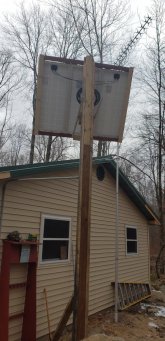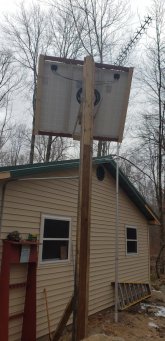HARG Hunter
Thirsty for Off-Grid Knowledge
I just installed my 3rd panel this weekend.
Before I left today, the sun was hitting the panels fully and the controller was telling me the panels were only sending 22 volts / 8 amps to the battery bank.
Tell me where to start troubleshooting.
Here is the set-up:
(3) 100 watt Renogy Mono panels
*They are connected to the Rover Elite 20 amp MPPT controller with 10AWG cable on a 40 foot run.
I have 190 ah worth of AGM batteries (All 3 months old or less):
(1) Universal Power Group 100ah AGM
(3) Mighty Max 30hm AGM's
Batteries all connected to each other with 6 or 8 AWG cable
I have a 12v DC water pump wired directly to the battery bank, with a switch.
A few details....
It has been in the 30's lately, and the battery bank is in an unheated cabin.
It's heated at 65+ when we're there.
The Rover Elite does have a temp sensor, so it should adjust for the differences in temps when we're there or not there.
Sun is low in the sky right now, but I do adjust the angle for the time of year, so the angle is almost exactly where it should be.
In full disclosure, it was 10 am when I checked before I left.
Inverter was not even connected to the battery bank when I checked to see what the panels were sending, so there is no draw.
I know that shouldn't matter, but I'm just trying to make sure I've got everything covered.
Maybe I'm not being patient enough.
Thoughts?
Before I left today, the sun was hitting the panels fully and the controller was telling me the panels were only sending 22 volts / 8 amps to the battery bank.
Tell me where to start troubleshooting.
Here is the set-up:
(3) 100 watt Renogy Mono panels
*They are connected to the Rover Elite 20 amp MPPT controller with 10AWG cable on a 40 foot run.
I have 190 ah worth of AGM batteries (All 3 months old or less):
(1) Universal Power Group 100ah AGM
(3) Mighty Max 30hm AGM's
Batteries all connected to each other with 6 or 8 AWG cable
I have a 12v DC water pump wired directly to the battery bank, with a switch.
A few details....
It has been in the 30's lately, and the battery bank is in an unheated cabin.
It's heated at 65+ when we're there.
The Rover Elite does have a temp sensor, so it should adjust for the differences in temps when we're there or not there.
Sun is low in the sky right now, but I do adjust the angle for the time of year, so the angle is almost exactly where it should be.
In full disclosure, it was 10 am when I checked before I left.
Inverter was not even connected to the battery bank when I checked to see what the panels were sending, so there is no draw.
I know that shouldn't matter, but I'm just trying to make sure I've got everything covered.
Maybe I'm not being patient enough.
Thoughts?






